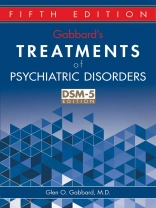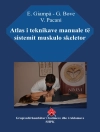The definitive treatment textbook in psychiatry, this fifth edition of Gabbard’s Treatments of Psychiatric Disorders has been thoroughly restructured to reflect the new DSM-5® categories, preserving its value as a state-of-the-art resource and increasing its utility in the field. The editors have produced a volume that is both comprehensive and concise, meeting the needs of clinicians who prefer a single, user-friendly volume. In the service of brevity, the book focuses on treatment over diagnostic considerations, and addresses both empirically-validated treatments and accumulated clinical wisdom where research is lacking.
Noteworthy features include the following: Content is organized according to DSM-5® categories to make for rapid retrieval of relevant treatment information for the busy clinician. Outcome studies and expert opinion are presented in an accessible way to help the clinician know what treatment to use for which disorder, and how to tailor the treatment to the patient. Content is restricted to the major psychiatric conditions seen in clinical practice while leaving out less common conditions and those that have limited outcome research related to the disorder, resulting in a more streamlined and affordable text. Chapters are meticulously referenced and include dozens of tables, figures, and other illustrative features that enhance comprehension and recall.
An authoritative resource for psychiatrists, psychologists, and psychiatric nurses, and an outstanding reference for students in the mental health professions, Gabbard’s Treatments of Psychiatric Disorders, Fifth Edition, will prove indispensable to clinicians seeking to provide excellent care while transitioning to a DSM-5® world.
สารบัญ
Contributors Introduction PART I: Neurodevelopmental Disorders and Elimination Introduction Chapter 1. Intellectual Developmental Disorder and Psychiatric Comorbidities Chapter 2. Communication Disorders Chapter 3. Autism Spectrum Disorders Chapter 4. ADHDChapter 5. Learning Disorders Chapter 6. Tic and Motor Disorders Chapter 7. Elimination Disorders Part II Schizophrenia Spectrum and Other Psychotic Disorders Chapter 8. Treating Psychosis in Adolescents and Early Psychosis Chapter 9. Understanding Psychosis as a Dimension Chapter 10. Psychosocial Treatments for Chronic Psychosis Chapter 11. Pharmacological Treatments for Psychosis Part III Bipolar and Related Disorders and Depressive Disorders Chapter 12. Psychotherapy of Mood Disorders Chapter 13. Acute and Maintenance Treatment of Bipolar Disorder Chapter 14. Treatment of Depressive Disorders Chapter 15. Brain Stimulation for Mood Disorders Part IV Anxiety Disorders and Obsessive-Compulsive and Related Disorders Chapter 16. Panic Disorders Chapter 17. Separation Anxiety Disorder Chapter 18. Social Anxiety Disorder Chapter 19. GADChapter 20. Specific Phobias Chapter 21. OCDChapter 22. Body Dysmorphic Disorder Chapter 23. Hoarding, Hairpulling, and Skin Picking Part V Dissociative Disorders and Trauma and Stressor-Related Disorders Chapter 24. DIDChapter 25. DPDChapter 26. DAChapter 27. PTSDChapter 28. ASDChapter 29. ADSPart VI Somatic Symptom Disorders and Feeding and Eating Disorders Chapter 30. Psychosocial interventions for EDChapter 31. Pharmacologic interventions for EDChapter 32. Intensive interventions (inpatient and partial hospitalization — day treatment) for EDChapter 33. Primary Care and Consultation Liaison Interventions Chapter 34. Pharmacologic Interventions for Psychosomatic Disorders Chapter 35. Intensive Interventions Part VII Sleep-Wake Disorders Chapter 36. Sleep Disorders Part VIII Paraphilias, Gender Dysphoria, and Sexual Dysfunctions Chapter 37. Paraphilias Chapter 38. Treatment of Gender Identity Disorders Chapter 39. Treatment of Sexual Dysfunctions Part IX Disruptive, Impulse Control, and Conduct Disorders Chapter 40. Oppositional Defiant Disorder Chapter 41. Conduct Disorder Chapter 42. Callous and Unemotional Specifier for Conduct Disorder Chapter 43. Intermittent Explosive Disorder Chapter 44. Pyromania Chapter 45. Kleptomania Part X Substance Use and Addictive Disorders Chapter 46. Alcohol-Related Disorders Chapter 47. Benzodiazepine and Other Sedative-Hypnotic Dependence Chapter 48. Detoxification Chapter 49. Antagonists Chapter 50. Agonist Maintenance Treatment (buprenorphine and methadone)Chapter 51. Hallucinogens Chapter 52. Marijuana Chapter 53. Club Drugs (MDMA, Ketamine, GHB, PCP, Ecstasy)Chapter 54. Stimulants (Cocaine and Methamphetamine)Chapter 55. Tobacco Chapter 56. Individual Therapy for Substance Abuse Disorders Chapter 57. Cognitive, Behavioral and Motivational Therapies for Substance Abuse Disorders Chapter 58. Group Therapy Chapter 59. Family Therapy Chapter 60. Network Therapy Chapter 61. Pain and Addiction Chapter 62. Gambling Part XI Neurocognitive Disorders Chapter 63. Delirium Chapter 64. Vascular Cognitive Impairment Chapter 65. Frontotemporal Dementia Chapter 66. Dementia Due to Alzheimer’s Disease Chapter 67. Parkinson’s Disease with Dementia Part XII Personality Disorders Chapter 68. Cluster A Disorders Chapter 69. Borderline Personality Disorder Chapter 70. Narcissistic Personality Disorder Chapter 71. Histrionic Personality Disorder Chapter 72. Antisocial Personality Disorder Chapter 73. Cluster C Disorders
เกี่ยวกับผู้แต่ง
Glen O. Gabbard, M.D., is Clinical Professor of Psychiatry at Baylor College of Medicine in Houston, Texas and Professor of Psychiatry at State University of New York in Syracuse. He is also Training and Supervising Analyst at the Center for Psychoanalytic Studies in Houston.











![ปกของ [奥]阿德勒: 自卑与超越 ปกของ [奥]阿德勒: 自卑与超越](https://static.worldofdigitals.com/thumb_webp/509/9787569513509.webp)
